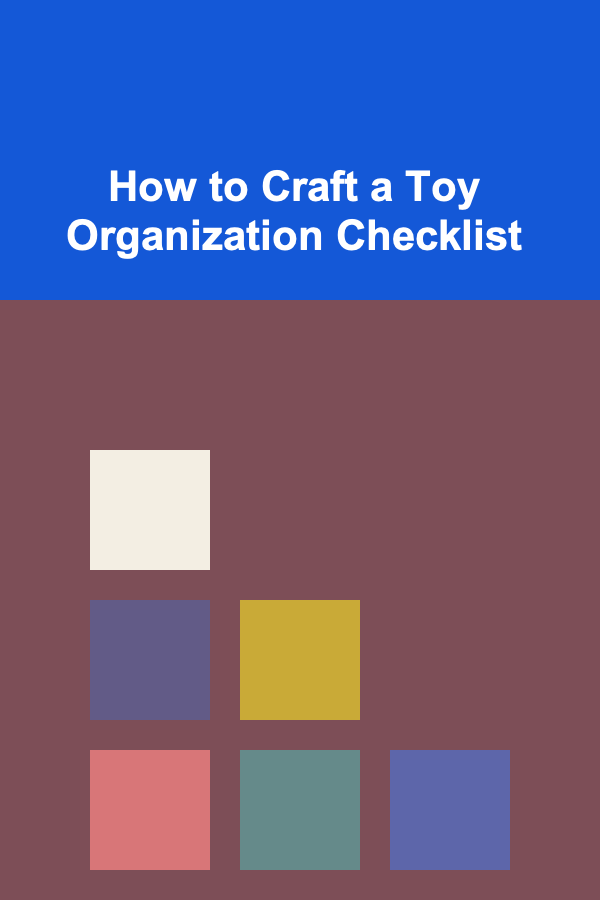
How to Craft a Toy Organization Checklist
ebook include PDF & Audio bundle (Micro Guide)
$12.99$6.99
Limited Time Offer! Order within the next:

Toy organization can often appear as a daunting task for parents and caregivers. With the rapid influx of toys in children's lives, maintaining an organized play area becomes increasingly challenging. However, with a structured approach---such as crafting a toy organization checklist---you can simplify this process, making it manageable and even enjoyable. This article aims to provide in-depth insights on how to create an effective toy organization checklist that not only helps keep your space tidy but also fosters a sense of responsibility and creativity in children.
Understanding the Importance of Toy Organization
Before diving into crafting a checklist, it's essential to understand why toy organization is crucial.
Benefits of Toy Organization
- Reduces Clutter: An organized space minimizes distractions, allowing children to focus on their activities.
- Encourages Responsibility: Teaching children to take care of their belongings instills a sense of responsibility and ownership.
- Enhances Creativity: A well-organized play area enhances children's ability to engage in imaginative play by ensuring they can easily find their toys.
- Promotes Safety: Reducing clutter can prevent accidents and ensure a safer play environment.
- Facilitates Learning: Organization can help children develop sorting and categorization skills.
Understanding these benefits lays the groundwork for creating an effective toy organization checklist.
Assessing Your Current Toy Situation
3.1. Inventory of Toys
The first step in creating a checklist is to assess the current state of your toy collection. Conduct a thorough inventory:
- List All Toys: Create a comprehensive list of all toys currently in your possession. This includes everything from stuffed animals to building blocks.
- Identify Favorites: Note which toys your child plays with most frequently and which ones are seldom touched.
- Check for Duplicates: Identify any duplicate toys that could be stored or donated.
3.2. Assessing Play Areas
Take stock of the areas where toys are typically used:
- Playroom: If you have a designated playroom, evaluate its layout and functionality.
- Living Room: Consider any toys that may be scattered in common areas.
- Bedrooms: Assess how toys are stored and accessed in your child's bedroom.
This assessment phase will provide valuable insights into what needs organizing and what strategies may be effective.
Creating the Toy Organization Checklist
With a clear understanding of your toy situation, you can begin crafting your toy organization checklist.
4.1. Categorizing Toys
Categorization is fundamental to effective organization. Here are some common categories:
- Action Figures/Characters
- Building Blocks/Construction Sets
- Arts and Crafts Supplies
- Puzzles and Games
- Books
- Outdoor Toys
- Stuffed Animals
Once you've identified categories, design your checklist to reflect these groupings.
4.2. Decluttering Process
Decluttering is essential for an effective organization. Your checklist should outline steps for decluttering:
- Sort Toys: Start by sorting toys into the previously identified categories.
- Evaluate Condition: Check each toy for damage. Decide if it can be repaired, recycled, or should be discarded.
- Involve Your Child: Encourage your child to participate in the decluttering process. Discuss which toys they genuinely enjoy and which they may be willing to donate.
4.3. Storage Solutions
Choose appropriate storage solutions for each category based on your available space:
- Bins and Baskets: Use labeled bins for easy access and visibility.
- Shelving Units: Install shelves for books and larger items.
- Wall Storage: Consider wall-mounted storage for small toys or arts and crafts supplies.
- Rotating Storage: For toys that are less frequently played with, consider using rotating storage that can be changed out periodically.
Your checklist should include specific recommendations for storage solutions suited to your home.
Implementing the Checklist
With the checklist in place, it's time to implement it effectively.
5.1. Timing and Frequency
Determine how often you will need to revisit your checklist:
- Seasonal Organization: Consider organizing toys at the change of each season.
- Post-Holidays: After holidays or birthdays, set aside time for organizing new toys.
- Monthly Maintenance: Incorporate a monthly decluttering session to maintain order.
Setting a routine ensures that toy organization becomes a household habit rather than an occasional chore.
5.2. Involving the Kids
Make toy organization a family activity:
- Team Effort: Organize toys together as a family. This teaches children teamwork and responsibility.
- Fun Activities: Turn the organization into a game. Challenge children to see who can sort their toys the fastest.
- Recognition: Celebrate each family member's contributions. Acknowledge their effort in maintaining a clean space.
By involving children in the process, you create a sense of shared responsibility and accomplishment.
Maintaining an Organized Space
After implementing your checklist, the next challenge is maintaining an organized space.
6.1. Regular Check-ins
Schedule regular check-ins to assess toy organization:
- Weekly Tidying Sessions: Dedicate a few minutes each week to tidying up the play area.
- Monthly Evaluations: Once a month, review the effectiveness of your organization system. Adjust as needed.
These check-ins will help ensure that the organization remains functional and responsive to changing needs.
6.2. Adapting to Change
Children grow and interests change. Be prepared to adapt your organization system to accommodate new toys and interests:
- Rotate Toys: Regularly switch out toys to keep things fresh and engaging.
- Update Categories: As your child's interests evolve, update your categorization to fit their current preferences.
Adapting your checklist and organization strategy to reflect these changes will keep your play area relevant and exciting.
Celebrating Organizational Success
Recognizing achievements is vital for encouraging continued efforts in toy organization.
7.1. Reflect on Accomplishments
After a successful organization session, gather as a family to reflect:
- Discuss What Worked: Talk about what aspects of the organization were successful and enjoyable.
- Personal Contributions: Allow each family member to share their favorite part of the day.
7.2. Treats and Rewards
Celebrate organizational successes with small rewards:
- Family Outing: Plan a fun family outing as a reward for collective effort in organizing.
- Special Activity: Have a movie night or special dessert to commemorate the hard work.
Celebrating successes reinforces the value of maintaining an organized environment and boosts morale for future efforts.
Conclusion
Crafting a toy organization checklist is an effective way to tackle the challenges of toy clutter in your home. By assessing your current situation, categorizing toys, and implementing actionable steps, you can create a functional and enjoyable play space for your children.
Involving kids in the process fosters a sense of responsibility and teamwork, while regular maintenance ensures that your organized environment remains sustainable. By recognizing and celebrating organizational successes, you instill positive habits that will benefit your family for years to come.
With these strategies, you can transform toy organization from a daunting task into a rewarding experience, cultivating an organized home that encourages creativity and play. Embrace the journey of toy organization, and watch as it enhances your family's dynamic and enjoyment of playtime.
Reading More From Our Other Websites
- [Home Cleaning 101] How to Tackle a Cluttered Garage and Keep It Tidy
- [Personal Care Tips 101] How to Combine a Facial Cleanser with Toners and Moisturizers for Better Results
- [Tiny Home Living Tip 101] Best Compact HVAC Systems for Year‑Round Comfort in Small Dwellings
- [Home Pet Care 101] How to Maximize Your Pet's Experience at the Pet Care Palace
- [Scrapbooking Tip 101] From Snapshots to Stories: Creative Photo Layouts for Your Next Scrapbook
- [Organization Tip 101] How to Handle Moving Difficult Items Like Pianos or Artwork
- [Personal Care Tips 101] How to Select the Best Hair Oil for Dry Hair
- [Weaving Tip 101] Step-by-Step Techniques for Creating Intricate Patterns in Blanket Weaving
- [Home Staging 101] How to Use Plants and Greenery to Liven Up Spaces
- [Organization Tip 101] How to Incorporate Natural Elements into Your Jewelry Display

How to Build Trust with Your Customers in the Automotive Niche
Read More
How to Create a Pet-Safe Garden for Outdoor Play
Read More
How to Stage Your Kitchen to Highlight Its Best Features
Read More
How to Use Light Fixtures to Enhance Your Home's Style
Read More
How To Train Your Brain for Better Decision-Making
Read More
The Art and Science of a Perfect Vinaigrette
Read MoreOther Products

How to Build Trust with Your Customers in the Automotive Niche
Read More
How to Create a Pet-Safe Garden for Outdoor Play
Read More
How to Stage Your Kitchen to Highlight Its Best Features
Read More
How to Use Light Fixtures to Enhance Your Home's Style
Read More
How To Train Your Brain for Better Decision-Making
Read More